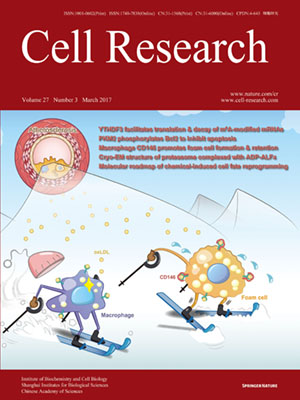
Volume 27, No 3, Mar 2017
ISSN: 1001-0602
EISSN: 1748-7838 2018
impact factor 17.848*
(Clarivate Analytics, 2019)
Volume 27 Issue 3, March 2017: 315-328
ORIGINAL ARTICLES
YTHDF3 facilitates translation and decay of N 6-methyladenosine-modified RNA
Hailing Shi1,2,*, Xiao Wang1,2,*, Zhike Lu1,2, Boxuan S Zhao1,2, Honghui Ma1,2, Phillip J Hsu1,2,3 and Chuan He1,2,4
1Department of Chemistry and Institute for Biophysical Dynamics, The University of Chicago, Chicago, IL 60637, USA
2Howard Hughes Medical Institute, The University of Chicago, Chicago, IL 60637, USA
3Committee on Immunology, The University of Chicago, Chicago, IL 60637, USA
4Department of Biochemistry and Molecular Biology, The University of Chicago, Chicago, IL 60637, USA
Correspondence: Chuan He, Tel: 773-702-5061(chuanhe@uchicago.edu)
N6-methyladenosine (m6A) is the most abundant internal modification in eukaryotic messenger RNAs (mRNAs), and plays important roles in cell differentiation and tissue development. It regulates multiple steps throughout the RNA life cycle including RNA processing, translation, and decay, via the recognition by selective binding proteins. In the cytoplasm, m6A binding protein YTHDF1 facilitates translation of m6A-modified mRNAs, and YTHDF2 accelerates the decay of m6A-modified transcripts. The biological function of YTHDF3, another cytoplasmic m6A binder of the YTH (YT521-B homology) domain family, remains unknown. Here, we report that YTHDF3 promotes protein synthesis in synergy with YTHDF1, and affects methylated mRNA decay mediated through YTHDF2. Cells deficient in all three YTHDF proteins experience the most dramatic accumulation of m6A-modified transcripts. These results indicate that together with YTHDF1 and YTHDF2, YTHDF3 plays critical roles to accelerate metabolism of m6A-modified mRNAs in the cytoplasm. All three YTHDF proteins may act in an integrated and cooperative manner to impact fundamental biological processes related to m6A RNA methylation.
10.1038/cr.2017.15
FULL TEXT | PDF
Browse 2145


